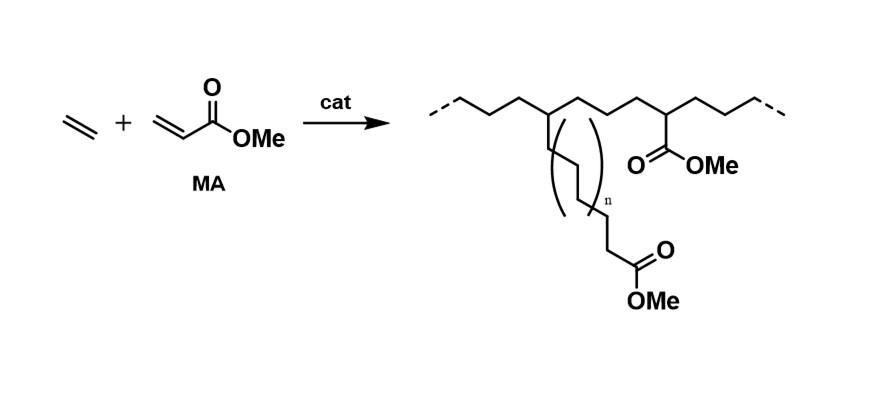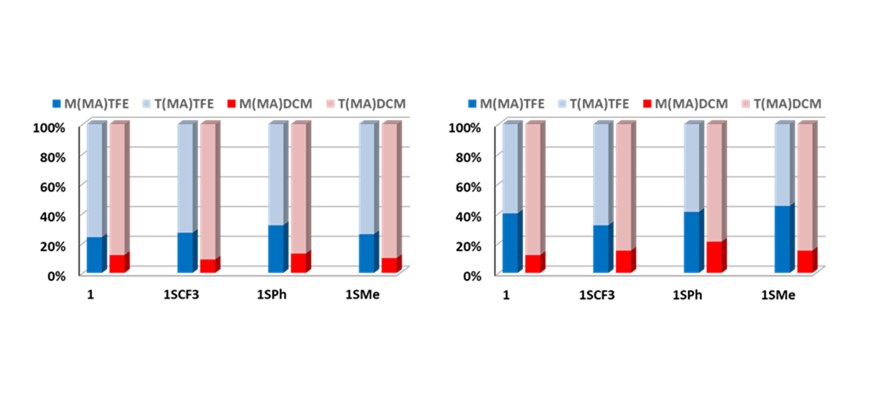PhD Top Stories
Chiara Alberoni
Tunable “in-chain” and “at the end of the branches” methyl acrylate incorporation in polyolefin skeleton through Pd(II) catalysis.
Doctoral Programme in Chemistry
Nowadays, our Society relies on the use of plastic materials whose global production, in 2019, reached the value of more than 360 milion tonnes. Among all the thermoplastic materials produced on industrial scale, polyolefins, in particular polyethylene and polypropylene, are the most versatile ones, covering about ? of the total demand of plastics. This is due to the high chemical stability and inertness of the polyolefin macromolecules that are only comprised of saturated C-C and C-H bonds. However, this high stability is considered as a doubled-edge sword: i. on one side it is at the base of their excellent physical, chemical and mechanical properties that make them suitable for an enormous range of applications, from automotive, to packaging to personal protective equipment; ii. on the other side it is responsible for their environmental pollution.
To move towards better performing materials the introduction of low amounts of polar functional groups into the polyolefin skeleton, obtaining the so called “functionalized polyolefins”, is a promising solution. Currently, functionalized polyolefins are industrially produced through technologies based on radical polymerization processes that require harsh reaction conditions and do not allow a good control over the polymer microstructure. The direct, controlled, homogeneously catalyzed copolymerization of terminal alkenes, such as ethylene, with polar vinyl monomers, such as methyl acrylate (MA), is considered as one of the most promising and environmentally friendly alternative technology to obtain these macromolecules (Figure 1). But now the main problem deals with finding a suitable catalyst able to achieve the target reaction fulfilling the industrial requirements of high activity and high control over the microstructure of the produced macromolecules with a particular focus on the amount and the way of polar monomer incorporation. In particular, from the industrial point of view the desired products are made of linear macromolecules having a content of polar monomer lower than 20 % and preferentially inserted into the main polymer chain (M(MA)).

Figure 1: Copolymerization of ethylene with methyl acrylate.
In this contribution we have investigated a new family of complexes, [Pd(CH3)(N-N)(N-S)][PF6], to be tested as catalysts for the target reaction. With respect to the main catalysts reported in literature, of general formula [Pd(CH3)(NCCH3)(N-N)][X], the newly studied ones have an hemilabile, potentially bidentate ligand, such as a thiophenimine, N-S, in the palladium coordination sphere. These new complexes generate active catalysts for the ethylene/methyl acrylate copolymerization, under mild reaction conditions of temperature and pressure, leading to the desired copolymers with a productivity up to 79 kilograms of copolymer per mol of palladium and a content of MA up to 8 mol %. Surprisingly enough, we have now discovered that the produced copolymers have the inserted acrylate both in the main chain (M(MA)) and at the end of the branches (T(MA)) depending on the solvent for the catalysis (dichloromethane or trifluoroethanol) and varying the N-S ligand (Figure 2).

Figure 2: Ethylene/MA copolymerization: effect of precatalyst and solvent on the way of MA enchainment.
Authors and affiliations
Chiara alberoni1, Massimo C. D’Alterio2, Gabriele Balducci1, Barbara Immirzi3, Maurizio Polentarutti4, Claudio Pellecchia2, Barbara Milani12Dipartimento di Chimica e Biologia "A. Zambelli", Università di Salerno, Via Giovanni Paolo II 132, I-84084 Fisciano (SA), Italia.
3Istituto per Polimeri, Compositi e Biomateriali, Consiglio Nazionale delle Ricerche, Via Campi Flegrei 34, 80078 Pozzuoli (NA), Italia
2Elettra – Sincrotrone Trieste, S.S. 14 Km 163.5 in Area Science Park, 34149 Basovizza, Trieste, Italia
Contact
Chiara Alberoni, email: chiara.alberoni@phd.units.itReference
Chiara Alberoni, Massimo C. D’Alterio, Gabriele Balducci, Barbara Immirzi, Maurizio Polentarutti, Claudio Pellecchia, Barbara MilaniTunable “in-chain” and “at the end of the branches” methyl acrylate incorporation in polyolefin skeleton through Pd(II) catalysis
ACS Catalysis 12, 3440 (2022).
DOI: 10.1021/acscatal.1c05326
Informazioni aggiornate al: 14.6.2022 alle ore 10:54
Contact: Webmaster - Università di Trieste pagina curata da: Research Doctorate

Piazzale Europa, 1 - 34127 - Trieste, Italia -
Tel. +39 040 558 7111 - P.IVA 00211830328
C.F. 80013890324 - P.E.C. ateneo@pec.units.it


